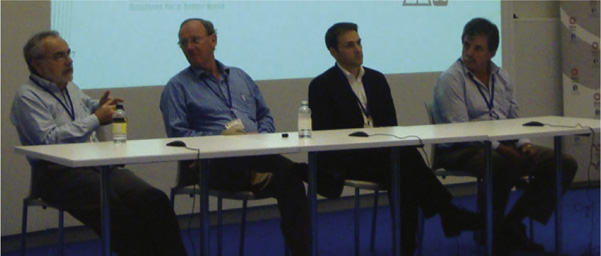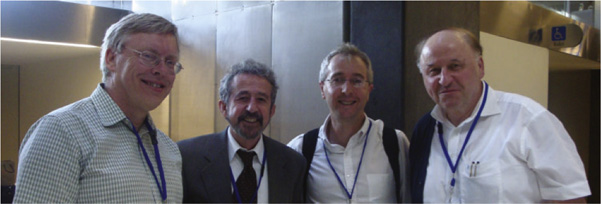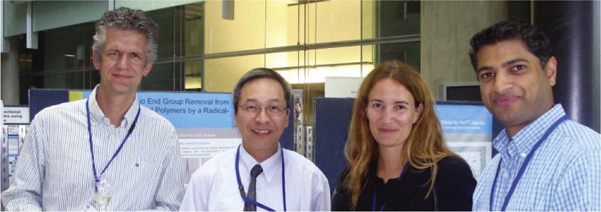RAFT Polymerization: Materials of The Future, Science of Today: Radical Polymerization – The Next Stage
Graeme Moad A B and San H. Thang AA CSIRO Molecular and Health Technologies, Bag 10, Clayton South, Vic. 3169, Australia.
B Corresponding author. Email: graeme.moad@csiro.au
Australian Journal of Chemistry 62(11) 1379-1381 https://doi.org/10.1071/CH09549
Published: 20 November 2009
This Research Front on RAFT polymerization came about as a consequence of the symposium ‘Materials of The Future, Science of Today: Radical Polymerization – The Next Stage’, which took place in Melbourne, Australia from 15 to 17 February 2009, using the facilities of the University of Melbourne’s Bio21 Institute.[1] For the most part, the Research Front comprises papers by speakers from that symposium.
The conference attracted ~116 participants from Australia, China, France, Germany, Iran, Japan, New Zealand, South Africa, and the USA. The International Advisory Board: Professor Jung-Il Jin (Korea), Professor Michael Buback (Germany), Professor Takeshi Fukuda (Japan), Associate Professor Greg Russell (New Zealand), and Professor Michael Fryd (USA). The Meeting was sponsored by IUPAC, the Royal Australian Chemical Institute Polymer Division, CSIRO, DuPont, and Davies Collison Cave. IUPAC sponsorship was vital in providing international recognition and credibility and in helping to attract high quality speakers many of whom came without funding from the conference.
The conference explored recent developments in radical polymerization and its application. A particular focus of the meeting was radical polymerization with reversible–addition fragmentation chain transfer (RAFT). The meeting also celebrated the 65th birthday and record of scientific achievement of Dr Ezio Rizzardo (CSIRO Molecular and Health Technologies), a pioneer of reversible deactivation radical polymerization and one of the inventors of the RAFT process.[2,3]
Following welcoming remarks by Dr Greg Simpson (Deputy Chief, CSIRO Molecular and Health Technologies), the conference commenced with a Pleanary lecture by Dr Rizzardo entitled ‘Perspectives of RAFT polymerization – something old and something new’, in which he announced a new class of ‘switchable’ RAFT agents.[4] Four speakers (Fig. 1) then provided an industrial perspective of the applications of RAFT polymerization with Professor Mike Fryd (on behalf of DuPont) ‘RAFT technology for microlithographic applications’, Professor Mathias Destarac (on behalf of Rhodia) ‘Some industrial aspects of the MADIX technology’, Mr Chris Such (Orica/Dulux) ‘RAFT polymerization – a coating technologists view’, and Kate Dawson (CSIRO) ‘RAFT – the new horizon’ mentioned the commercial availability of research quantities of RAFT agents through Strem[5] and announced the formation of the ‘RAFT Alliance’. The RAFT Alliance is a CSIRO-facilitated, global knowledge exchange community, enabling members to network and share recent developments in both RAFT-related research findings and industrial applications. It is intended that membership will be free to academia. Those not a member of the RAFT Alliance can join at: http://www.csiro.au/services/RAFT-Alliance-Sign-Up.html.

|
Other plenary speakers were Professor Andrew B. Holmes (CSIRO Molecular and Health Technologies and Bio21 Institute) ‘Seeing the light with polymers’,[6] Professor Thomas P. Davis (University of New South Wales) ‘The stabilization and biofunctionalization of iron oxide nanoparticles’,[7] Professor Bert Klumperman (Stellenbosch University) ‘RAFT-mediated polymerization towards advanced macromolecular architectures’, Professor Krzysztof Matyjaszewski (Carnegie Mellon University) ‘ATRP and RAFT: taking the best of each world’,[8] Professor Heather D. Maynard (University of California, Los Angeles) ‘RAFT polymerization to synthesize polymer bioconjugates for therapeutic applications’, and Professor Charles B. McCormick (University of Southern Mississippi) ‘Aqueous RAFT polymerization – a technology relevant to biomedicine’.
Professor Dr Christopher Barner-Kowollik (Karlsruhe University) could not be present in person and provided a pre-recorded ‘virtual’ presentation entitled ‘Ultra-rapid orthogonal conjugations based on RAFT and Hetero Diels–Alder chemistry’.[9] In all, there were 23 presentations and 23 posters presented over the two and a half days of the conference. All delegates benefited from extensive networking opportunities during both informal/social events and structured panel and poster sessions (Figs. 2, 3). The conference program and selected presentations remain available on line at the RAFT Alliance website (http://teams.csiro.au/sites/RAFT/default.aspx).

|

|
As the centrepiece of this Research Front, Moad, Rizzardo, and Thang[10] provide a second update on ‘Living radical polymerization by the RAFT process’, which covers the literature on RAFT polymerization that has appeared since publication of the first update, which was published in the Australian Journal of Chemistry in late 2006.[11] The first review in this series was published in the Australian Journal of Chemistry in June 2005.[12] Both previous reviews are highly cited.
In ‘Synergistic interaction between ATRP and RAFT: taking the best of each world’, Kwak, Nicolay, and Matyjaszewski[8] discuss the selection of R- and Z- groups in RAFT agents (ZC(= S)S-R) and R- and halogen in ATRP initiators (R-X) and reviews the use of combinations of RAFT and ATRP to undertake polymer syntheses that are difficult or not possible with the current form of either technique.
The kinetics and mechanism of RAFT polymerization feature in several papers. Lin and Coote[13] ask the question ‘How well can theory predict addition–fragmentation equilibrium constants in RAFT polymerization?’. Buback, Meiser, and Vana[14] examine the influence of pressure and RAFT agent concentration on RAFT polymerization of methyl methacrylate mediated by cumyl dithiobenzoate. Brown et al.[15] describe the use of thiocarbonylthio end-group removal (Raney Nickel) and a fluorescent (Z = carbazole) RAFT agent as aids in providing evidence for the mechanism of retardation observed in some RAFT polymerizations.
Other papers detail the synthesis of specific polymers or types of polymer using the RAFT process. Ma, Cheng, and Wooley[16] demonstrate that RAFT polymerization can be used to synthesize copolymers based on monomers containing pendant norbornene units. This functionality, which is unreactive under RAFT polymerization conditions, can be made use of is in the subsequent transformation of the copolymer by ring-opening metathesis polymerization or thiol-ene reactions to synthesize nanoparticles (star polymers). Xu, Smith, and McCormick[17] describe a one-pot process for the preparation of shell-crosslinked micelles (SCM) based on self-assembly of the RAFT-synthesized stimuli responsive triblock copolymer and disulfide crosslinking. The SCM can be addition of a reducing agent, dithiothreitol, and re-crosslinked by exposure to air. Alconel et al.[18] describe the use RAFT polymerization to synthesize the ionomer, poly(sodium 4-styrenesulofonate-co-poly(ethylene glycol) methyl ether acrylate), which is transformed by sequential aminolysis and Michael reaction with divinyl sulfone.
Sprong et al.[19] show that particle morphology developed in ab initio RAFT emulsion polymerization depends on the nature of the amphiphilic macro RAFT agent used. Destarac et al.[20] examine thermoresponsive amphiphilic block copolymers prepared with xanthate RAFT agents (MADIX) as stimuli responsive emulsion stabilizers.
Goto et al.[21] describe the application of reversible chain transfer-catalyzed polymerization to methyl methacrylate. This process can be seen as mechanistically analogous to ATRP and involves an iodo-compound as the dormant species and a nitrogen or phosphorus-cantered radical as activator.
[1]
[2]
[3]
J. Chiefari,
Y. K. Chong,
F. Ercole,
J. Krstina,
J. Jeffery,
T. P. T. Le,
R. T. A. Mayadunne,
G. F. Meijs,
C. L. Moad,
G. Moad,
E. Rizzardo,
S. H. Thang,
Macromolecules 1998, 31, 5559.
| Crossref | GoogleScholarGoogle Scholar |
CAS |
| Crossref | GoogleScholarGoogle Scholar |
CAS |
[verified October 2009].
[6]
A. C. Grimsdale,
K. L. Chan,
R. E. Martin,
P. G. Jokisz,
A. B. Holmes,
Chem. Rev. 2009, 109, 897.
| Crossref | GoogleScholarGoogle Scholar |
CAS |
| Crossref | GoogleScholarGoogle Scholar |
CAS |
| Crossref | GoogleScholarGoogle Scholar |
|
CAS |
| Crossref | GoogleScholarGoogle Scholar |
| Crossref | GoogleScholarGoogle Scholar |
CAS |
| Crossref | GoogleScholarGoogle Scholar |
CAS |
| Crossref | GoogleScholarGoogle Scholar |
| Crossref | GoogleScholarGoogle Scholar |
| Crossref | GoogleScholarGoogle Scholar |
| Crossref | GoogleScholarGoogle Scholar |
| Crossref | GoogleScholarGoogle Scholar |
| Crossref | GoogleScholarGoogle Scholar |
| Crossref | GoogleScholarGoogle Scholar |
| Crossref | GoogleScholarGoogle Scholar |
| Crossref | GoogleScholarGoogle Scholar |



